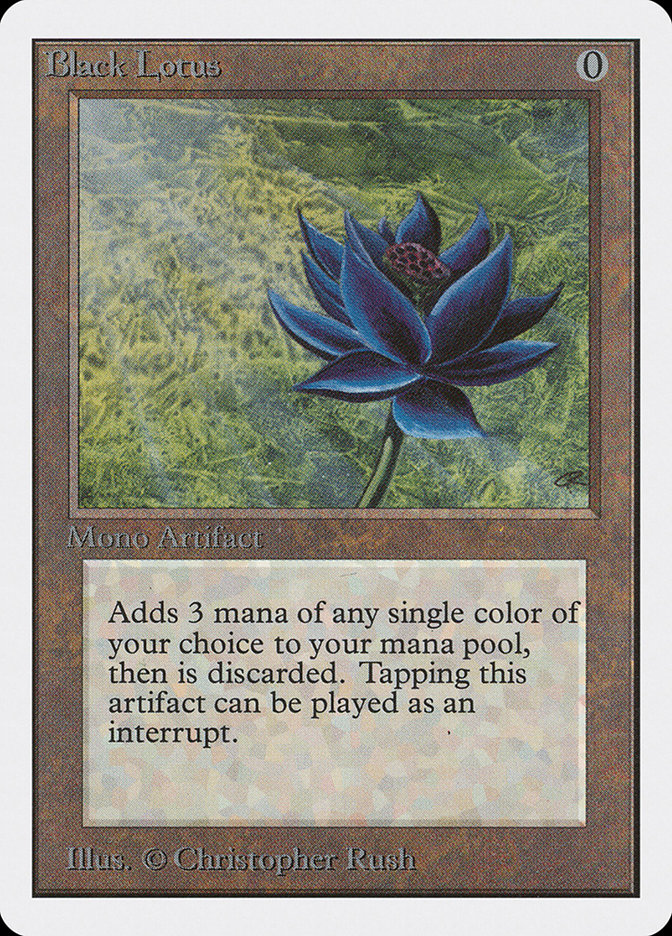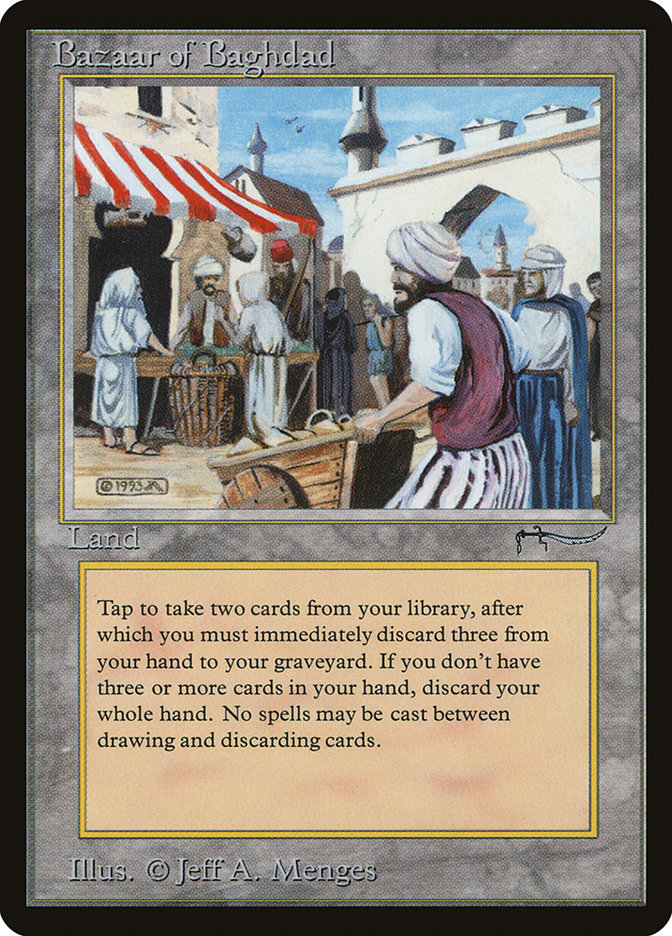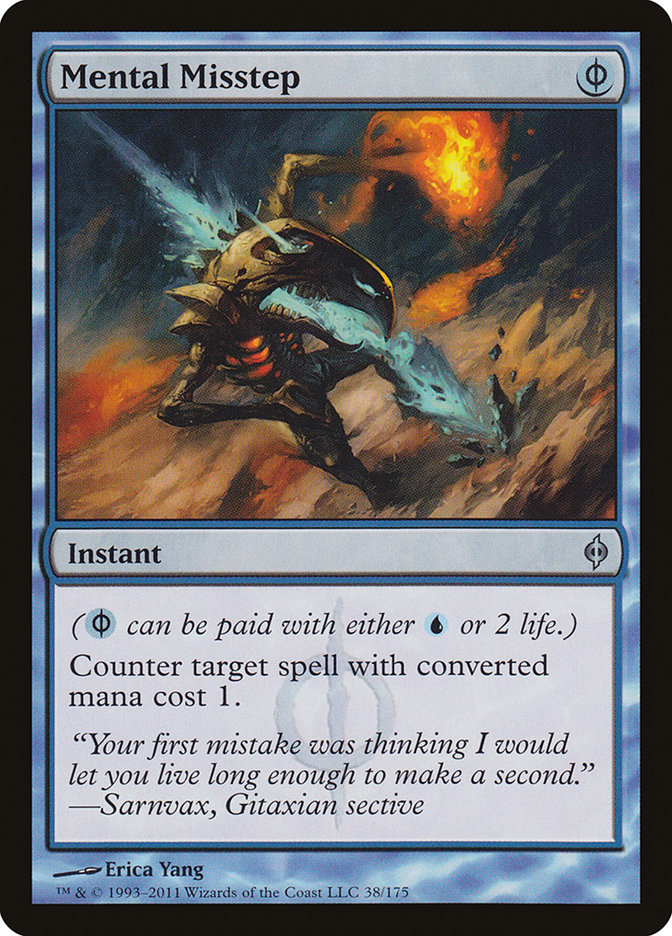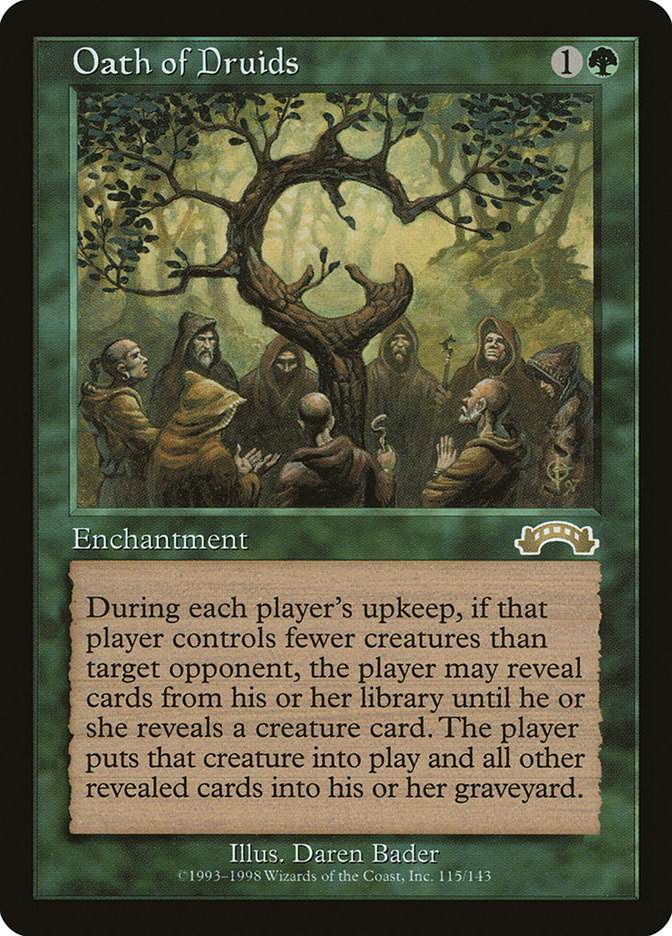I’ve secretly/not-so-secretly been interested in Vintage for quite some time now. My interest level definitely peaked sometime last year when I watched coverage of Reid Duke playing the storm combo deck. I truly regretted not being able to play in the Vintage event after the fact, and I hope to borrow some cards and play in the event next time around. With that being said, obviously, I don’t have the Power Nine or some of the more specialized cards like Time Vault, Mana Crypt, or even Mana Drain that I would need to play some of the decks I might otherwise want to play.
As it turned out though, I didn’t even know the half of it.
The powers (get it?) that be decided to give us closet-Vintage enthusiasts a break and release the cards online where they demand only a fraction of their real life retail price. This is great for me. I can borrow the cards I need pretty easily now, and owning them outright doesn’t demand the kind of investment the real life copies require (although I do one day hope to own them in real life as well). Other than some fun games between rounds at an Oregon PTQ this year, I haven’t held a Black Lotus in a long time.
I’ve been playing Vintage online for the better part of the last two weeks, and more importantly, I’ve been enjoying it. I won’t say I was never of the opinion that Vintage was stupid, and while most people feel (incorrectly) that games always end on turn 1, I was of the opinion that it was the player who mulliganed correctly in the face of the player who perhaps did not that would always or usually win. Now I feel my biggest weakness is perhaps the shallowness of my understanding of how to sideboard. I’ve also done myself a favor by playing decks that are slightly more streamlined and singular in their mission, which makes my mulligan decisions a bit easier. Still, there are a lot of subtle plays to make and a lot of room for improvement (at least for me), and while I don’t think Standard is easy or that I’m especially good at it, I do feel like it’s simple by comparison. Some part of that is the fact that I haven’t been exposed to playing with a lot of these cards for a while. Even something like Mental Misstep, which I did play with a long time ago (when it was legal in Legacy), is something you have to re-learn. For example, when my opponent Mental Misstep-ed my Sol Ring the other night, I should have responded with Ancestral Recall. Not doing so allowed him to cast Snapcaster Mage and completely blow me out, but this was quite avoidable, obviously.
So, while the scope of this article cannot promise to be the entirety of the format, I would like to talk about what I’ve learned and what I’ve liked so far.
First, we have to discuss a few weird boundaries that exist in this format.
For anyone who has played with or against Legacy dredge, you will understand the implications of having access to this card:
Uncounterable, basically unstoppable dredging in a quantity that is definitely dangerous. I don’t know enough to know how good turn 1 of game 1 usually goes for Dredge, but I can imagine it’s scary-good. Unfortunately for Dredge enthusiasts, it seems that the dredge deck, while able to access virtually any card in Magic’s history thanks to the legality-rules of Vintage, cannot hope to compete against a field of hateful sideboards. Yixlid Jailer, Tormod’s Crypt, Ravenous Trap, and Leyline of the Void are common enough sideboard cards, but Grafdigger’s Cage and Nihil Spellbomb seem to be maindeckable in some builds. This means you might not even get to win your “free” game 1–the reason you might be playing Dredge in the first place is that you have such a high win percentage for game 1 that it’s worth gambling for games 2 and 3 that their sideboard cards don’t show up, they mulligan too much, you draw your answers, etc. If they have access to Cage maindeck because they’re playing Trinket Mage and it kills Oath of Druids and isn’t so bad against Snapcaster and Yawgmoth’s Will, you’re going to lose out even more.
Still, even with all of this, Dredge is scary to play against and requires careful planning during both deckbuilding and mulliganing. I would not want to leave home without enough cards in my sideboard. I played in one daily where my hand was great, but as early as turn 2 of game 1 I knew I was simply dead as my opponent had started with Bazaar and Chalice of the Void on 0. It’s nice to not run any Moxen as it allows you to play Chalice on 0 freely. Similarly, it’s nice when you don’t run Snapcaster or Yawgmoth’s Will in order to run maindeck Cage to mess with the people who do.
The next biggest boogeyman of the format seems to be the decks that run Workshops and multiple prison or “lock” pieces or “taxing effects” such as Sphere of Resistance, Thorn of Amethyst, and of course Juggernaut Lodestone Golem. These decks seem to be called MUD and Stax, but I don’t yet know the nuanced differences between the two. I just know that invariably they will play a two-drop on turn 1 off of a Workshop or an Ancient Tomb. Turn 2 is usually more of the same. These decks punished me for my early transgressions of trying to cast Tendrils of Agony for more than one. In my later life (which is to say, the last few days), I have been able to win a match against these strategies here and there. Obviously my sample size is extremely small and I am no expert, but I am more afraid of these decks than I am of Dredge.
I suppose the sideboard cards are better against Dredge, and I don’t have to worry about being able to cast them like I do here since Chalice of the Void for one shuts off Nature’s Claim and Witchbane Orb (which shuts off Oath of Druids and Forbidden Orchard, also Hurkyl’s Recall). Even if I do draw Rebuild, it costs three mana plus whatever else (taxes…). Let’s just say it’s a long shot! Decks seem to run one maindeck Hurkyl’s Recall and one more in the sideboard almost universally, and I’ve seen Steel Sabotage in a lot of places as well. The RUG Delver decks seem to run an Ancient Grudge in the maindeck. It’s this deck that makes playing red in your deck an interesting proposition because being able to play Ingot Chewer is kind of a big game. For one thing, it’s R to destroy an artifact which is about par for the course. But, the fact that Thorn of Amethyst doesn’t affect it (since it’s technically a creature even if you use evoke) is a big deal. In games where you cast it, having it in play is also great for when they play one of their many Tangle Wires. I also have a Rack and Ruin in one of my sideboards which I flashed back with a Snapcaster Mage in one of the games I managed to win. It was great (for me.)
This brings us to Oath of Druids. This might be the dumbest card in the format, and that’s saying a lot! Consider that all the non-ante cards in the game are legal, and this one is coming out on top.
Now, after speaking to a few people and playing a lot of games with a few decks, I’m of the opinion that Mental Misstep is a stupid card in this format. It’s random in that you can’t really play with it strategically, you just need to play it when they give you a chance, and on the other side of the screen you just need to hope you don’t run into it. The added “layer of complexity” of casting Demonic Tutor and getting Gush instead of Ancestral Recall because they might have Mental Misstep is not enough to make me appreciate the presence of the card.
Oath of Druids is stupid for a different reason. In Legacy, you can play a Griselbrand for 2U but with the understanding that your opponent will also get to put a permanent into play. It might be Karakas, it might be Pithing Needle, it might be Humility, it might be any number of things that can screw up your Griselbrand. In this format, Griselbrand costs 1G and requires you to run an upgraded City of Brass in your deck as the cost (along with the Oath itself). Sometimes, I get tired of Worth giving me both Griselbrands in my opening hand, especially with Brainstorm restricted–it’s hard to get them back into the deck so you generally need to mulligan those hands–but other than that, this is an insane cost for Griselbrand which let me remind you, was intended to cost a full eight mana. Of that eight mana, a full half were black. As I said before, in Legacy people are aware of the Sneak and Show menace. They know that they need to build with it in mind and they do so. Death and Taxes wouldn’t be a deck if it didn’t beat Sneak and Show so handily. In Vintage, everyone knows about Oath of Druids and how stupid it is, yet they don’t include answers to it in their deck except in the case of the BUG Fish deck, which has four Abrupt Decays. This is the part that I don’t understand. Abrupt Decay is a great card in the format since it can hit Time Vault which is also widely played and equally scary!
So, as you can imagine I started off with Reid’s Storm deck, which looks like this:
Creatures (1)
Lands (12)
Spells (47)
- 1 Tendrils of Agony
- 1 Brainstorm
- 1 Cabal Ritual
- 1 Yawgmoth's Bargain
- 1 Vampiric Tutor
- 1 Mystical Tutor
- 1 Yawgmoth's Will
- 4 Duress
- 1 Necropotence
- 1 Mana Vault
- 1 Wheel of Fortune
- 1 Sol Ring
- 1 Demonic Tutor
- 1 Hurkyl's Recall
- 1 Time Walk
- 4 Dark Ritual
- 1 Ancestral Recall
- 1 Imperial Seal
- 1 Grim Tutor
- 1 Mana Crypt
- 1 Windfall
- 1 Timetwister
- 1 Mind's Desire
- 1 Chain of Vapor
- 1 Tinker
- 1 Black Lotus
- 1 Lotus Petal
- 1 Lion's Eye Diamond
- 1 Mox Emerald
- 1 Mox Jet
- 1 Mox Pearl
- 1 Mox Ruby
- 1 Mox Sapphire
- 1 Chrome Mox
- 1 Ponder
- 1 Mox Opal
- 1 Mental Misstep
- 4 Gitaxian Probe
Sideboard

This is a pretty traditional Storm list and one that I was initially winning with. The feeling of drawing Black Lotus and playing turn 1 Wheel of Fortune or Windfall or even Timetwister after playing a few things for free was a great feeling. I think the Blightsteel Colossus in the main, which is how I was winning a lot of my games in conjunction with Time Walk, is unnecessary and would be better served as a Memory Jar. The good part of this deck is that it is fully going for it. Every card is a Duress, a mana source, or a way to win. I give Gitaxian Probe a pass due to its obvious synergy with the deck (free knowledge and free storm count? Sign me up). You also don’t have to mulligan hands for containing too many Griselbrands or Oaths or whatever. I was not aware this was a bonus until a little later in my education. The bad parts are that it is a little weak to the cards people are actually playing. Flusterstorm is an absurd card when you make it one, and this deck makes it one. Force of Will on a key draw seven is also a real problem. In general, while this deck is capable of getting an absurd draw and easily winning or providing a very threatening set of opening turns for your opponent to deal with, I think it’s too weak to Flusterstorm to justify playing it. I also lost to someone online playing with four maindeck Mindbreak Traps to go with their Voidmage Prodigy and Snapcaster Mage deck. Sometimes, it seems having a backup plan is better than being all-in.
From there I moved to the deck that won a Bazaar of Moxen tournament recently that looked like this:
Creatures (3)
Planeswalkers (4)
Lands (15)
Spells (38)
- 1 Sensei's Divining Top
- 1 Brainstorm
- 4 Mana Drain
- 1 Vampiric Tutor
- 1 Mystical Tutor
- 1 Yawgmoth's Will
- 4 Force of Will
- 1 Mana Vault
- 1 Sol Ring
- 1 Demonic Tutor
- 1 Time Walk
- 1 Ancestral Recall
- 1 Mana Crypt
- 1 Time Vault
- 1 Thirst for Knowledge
- 1 Misdirection
- 1 Tinker
- 1 Voltaic Key
- 1 Black Lotus
- 1 Fact or Fiction
- 1 Mox Emerald
- 1 Mox Jet
- 1 Mox Pearl
- 1 Mox Ruby
- 1 Mox Sapphire
- 1 Spell Snare
- 2 Steel Sabotage
- 2 Mental Misstep
- 1 Flusterstorm
- 1 Toxic Deluge

This deck was an interesting mix of strategies and unfortunately I had to just dive in without understanding all of the choices made in deck-building. I still don’t understand why it’s one maindeck Toxic Deluge instead of whatever else or why it’s only Rune-Scarred Demon instead of the Grisfather in the sideboard, although I do think Rune-Scarred Demon is probably enough most of the time. I did enjoy Time Vaulting people right out of the tournament and Tezzeret the Seeker seemed incredibly powerful in comparison to Jace, the Mind Sculptor for whom my love knows no bounds; at least you can still turn 1 Jace off a Lotus a little more easily than you can Tezzeret. It was pretty easy to see that Oath was the better part of the deck here even though it was just in the sideboard. Oath of Druids invalidated a lot of my opponents’ strategies, and it quickly became apparent to me that it was probably what I wanted to be doing. However, I got it into my head that I wanted to be casting Gush and having a Fastbond in play, so I gave that a try first.
This deck won a tournament in Spain a few months ago:
Creatures (2)
Planeswalkers (2)
Lands (14)
Spells (41)
- 1 Tendrils of Agony
- 1 Brainstorm
- 1 Fastbond
- 2 Mana Drain
- 1 Vampiric Tutor
- 1 Mystical Tutor
- 1 Yawgmoth's Will
- 4 Force of Will
- 1 Sol Ring
- 1 Demonic Tutor
- 1 Hurkyl's Recall
- 1 Time Walk
- 1 Ancestral Recall
- 1 Mana Crypt
- 4 Gush
- 1 Timetwister
- 1 Merchant Scroll
- 3 Mystic Remora
- 1 Tinker
- 1 Black Lotus
- 1 Mox Emerald
- 1 Mox Jet
- 1 Mox Ruby
- 1 Mox Sapphire
- 2 Mindbreak Trap
- 3 Preordain
- 3 Mental Misstep

Again, it isn’t my list so I don’t understand all the choices being made. This deck presented a few interesting maindeck choices to me. For one, why is there a maindeck Talrand? Well, it turns out Talrand is actually great against the BUG Fish deck. I just wonder if being a HUGE liability against Oath of Druids is worthwhile. I played one game where I was doing just fine and had planned on winning. I cast Talrand to create a new angle of attack and create some new pressure while I was building up to actually “going off” with Fastbond (by the way, Fastbond is flat out absurd.) Then my opponent cast an Oath of Druids which I was not expecting (he had no Forbidden Orchard and given that he was just playing good cards, I wasn’t really under the impression that he’d be playing Oath of Druids.) Anyway, I Forced, he Forced, then I lost. Had I not played Talrand–or been tempted to–I would not have lost in that exact fashion. This is a failing on my part. I had inexperience with the format, and I certainly didn’t know what my opponent was playing.
Next up was the Mindbreak Traps which I’ve actually seen in the maindeck in a few places, but I can’t help but wonder if it’s just a hat-tip to the local metagame. Like I said, this deck won a tournament in Spain but maybe this person knew what to expect? If there’s a lot of Storm in my local Vintage metagame and I run Mindbreak Traps main to beat them, that wouldn’t be so strange, would it? Mindbreak Trap actually has a fair bit of use against something like Yawgmoth’s Will, and it’s blue so you can just Force with it if you need to. I actually enjoyed this list and Merchant Scroll is a great card. This was the deck that taught me to tutor for Gush instead of Ancestral in the face of Mental Misstep which was a valuable lesson. Now, this is all with Mystic Remora in the maindeck as well which I thought was “good enough” against Storm (but now I don’t think it is, you really need to draw into Counterspells, then it’s enough.) Mystic Remora is another one that seems metagame specific. I played this deck online and ran into some Dark Confidants… it wasn’t pretty. I think my conclusion is that while Fastbond is an amazing card when combined with Gush (you should really try it!), Mystic Remora is not an amazing card whatsoever. I may have had some fondness for it leftover from High Tide Extended season about sixteen years ago, but I digress.
Next up for me were the Oath variants. I started out with the fair one, which aims to put Griselbrand into play and then not win immediately:
Creatures (2)
Planeswalkers (3)
Lands (16)
Spells (39)
- 1 Sensei's Divining Top
- 1 Brainstorm
- 2 Mana Drain
- 1 Show and Tell
- 1 Vampiric Tutor
- 1 Mystical Tutor
- 4 Oath of Druids
- 1 Yawgmoth's Will
- 4 Force of Will
- 1 Sol Ring
- 1 Demonic Tutor
- 1 Gaea's Blessing
- 1 Hurkyl's Recall
- 1 Time Walk
- 1 Ancestral Recall
- 1 Mana Crypt
- 1 Time Vault
- 1 Misdirection
- 1 Voltaic Key
- 1 Black Lotus
- 1 Mox Emerald
- 1 Mox Jet
- 1 Mox Pearl
- 1 Mox Ruby
- 1 Mox Sapphire
- 1 Ponder
- 1 Thoughtseize
- 2 Mental Misstep
- 2 Abrupt Decay
- 1 Swan Song

This deck is great. Mana Drain is great and worth exploring. Time Vault is great and winning at your leisure with a Griselbrand is great. The Oath wars (that is to say the Oath mirror) is a bit stupid. You can’t cast Oath for fear of them just having an Orchard and getting a free Griselbrand, so having a backup plan (Time Vault) is pretty good. However, this was the other Oath deck I was trying. Admittedly, I think the backup plan in this one is pretty good too:
Creatures (2)
Lands (12)
Spells (46)
- 1 Brainstorm
- 1 Yawgmoth's Bargain
- 1 Vampiric Tutor
- 1 Mystical Tutor
- 4 Oath of Druids
- 4 Duress
- 1 Necropotence
- 1 Mana Vault
- 1 Wheel of Fortune
- 1 Sol Ring
- 1 Demonic Tutor
- 1 Hurkyl's Recall
- 1 Time Walk
- 4 Dark Ritual
- 1 Ancestral Recall
- 1 Grim Tutor
- 1 Mana Crypt
- 1 Windfall
- 1 Timetwister
- 4 Burning Wish
- 1 Mind's Desire
- 1 Defense Grid
- 1 Chain of Vapor
- 1 Black Lotus
- 1 Lotus Petal
- 1 Lion's Eye Diamond
- 1 Mox Emerald
- 1 Mox Jet
- 1 Mox Pearl
- 1 Mox Ruby
- 1 Mox Sapphire
- 2 Chrome Mox
- 1 Mox Opal

Indeed, I think this is perhaps even more unfair than the Storm deck we looked at first. Both decks mulligan a fair bit and for different reasons, but putting Griselbrand into play and then immediately winning has to be the best thing we can do in this format. Oath is two mana and is a must-counter, and we have the same backbreaking Duresses to force through our plan. Burning Wish occupies an interesting space in this deck. Having a “wish board” seems mostly bad. Getting Show and Tell has occasionally served me well, and the same can be said for Thoughtseize and, of course, Shattering Spree is great (although I do sometimes just board those in instead, since casting Burning Wish can be pretty unreliable when you really want to Shattering Spree.) The fact that it lets you have four chances at drawing a Yawgmoth’s Will that costs 3BR, however, is the real beauty of it. Yawgmoth’s Will deserves a full 600-page novel written by someone more versed in it than I am, so I won’t bother. Suffice to say though, most games are essentially over when the card resolves. Can you believe some decks don’t play it?
Creatures (16)
- 4 Dark Confidant
- 2 Trygon Predator
- 1 Vendilion Clique
- 1 Scavenging Ooze
- 3 Snapcaster Mage
- 4 Deathrite Shaman
- 1 True-Name Nemesis
Planeswalkers (1)
Lands (18)
Spells (25)
- 1 Brainstorm
- 1 Vampiric Tutor
- 4 Force of Will
- 1 Demonic Tutor
- 1 Time Walk
- 1 Ancestral Recall
- 1 Black Lotus
- 1 Mox Emerald
- 1 Mox Jet
- 1 Mox Sapphire
- 3 Spell Pierce
- 1 Steel Sabotage
- 3 Mental Misstep
- 1 Flusterstorm
- 4 Abrupt Decay
Sideboard

For all its “normalness” this deck actually puts up a pretty good fight. I’ve seen a lot of varying builds including one with a maindeck Null Rod that might be the right direction to move, and Black Lotus also seems like it might not make sense in this deck. If you added more Jaces, it might still be good. It’s odd to say that Black Lotus might not fit into a deck, but here we are. The biggest thing I took away from this deck is that sometimes if you see Mox Pearl, it can be pretty easy to tell what deck your opponent is playing. This deck is popular and doesn’t play it, RUG Delver also doesn’t play it (and is also popular–if you see Gush and Mox Pearl, they’re playing a different deck.) This is also a great Flusterstorm deck, and Snapcastering an Ancestral or a Time Walk feels about as good as you can imagine.
Finally, I just want to thank LSV and Tommy Ashton for their help in preparing some Vintage games as well as this article.
I know that I am not a Vintage expert and I am sure I will get shouted down by some of those in the comments, but I would also be happy to hear any critiques about the article and perhaps if you’d like to read more about my experiences in Vintage. Hell, I’d even record a Vintage daily if I could. Please let me know!





